产品中心
当前位置:首页>产品中心Anti-CPLX1
货号: bs-11341R 基本售价: 1380.0 元 规格: 100ul
- 规格:100ul
- 价格:1380.00元
- 规格:200ul
- 价格:2200.00元
产品信息
- 产品编号
- bs-11341R
- 英文名称
- CPLX1
- 中文名称
- Complexin I/复合素1抗体
- 别 名
- complexin 1; Complexin I; Complexin-1; CPLX1; CPLX1_HUMAN; CPX I; CPX-I; CPX1; Synaphin 2; Synaphin-2; 921-S.
- 规格价格
- 100ul/1380元购买 200ul/2200元购买 大包装/询价
- 说 明 书
- 100ul 200ul
- 研究领域
- 细胞生物 神经生物学 信号转导 结合蛋白
- 抗体来源
- Rabbit
- 克隆类型
- Polyclonal
- 交叉反应
- Human, Mouse, Rat, Chicken, Pig, Cow,
- 产品应用
- WB=1:500-2000 ELISA=1:500-1000 IHC-P=1:400-800 IHC-F=1:400-800 ICC=1:100-500 IF=1:100-500 (石蜡切片需做抗原修复)
not yet tested in other applications.
optimal dilutions/concentrations should be determined by the end user.
- 分 子 量
- 15kDa
- 细胞定位
- 细胞浆
- 性 状
- Lyophilized or Liquid
- 浓 度
- 1mg/ml
- 免 疫 原
- KLH conjugated synthetic peptide derived from human CPLX1:31-100/134
- 亚 型
- IgG
- 纯化方法
- affinity purified by Protein A
- 储 存 液
- 0.01M TBS(pH7.4) with 1% BSA, 0.03% Proclin300 and 50% Glycerol.
- 保存条件
- Store at -20 °C for one year. Avoid repeated freeze/thaw cycles. The lyophilized antibody is stable at room temperature for at least one month and for greater than a year when kept at -20°C. When reconstituted in sterile pH 7.4 0.01M PBS or diluent of antibody the antibody is stable for at least two weeks at 2-4 °C.
- PubMed
- PubMed
- 产品介绍
- background:
Complexin 1 and Complexin 2, also designated Synaphin 1 and Synaphin 2, contain an a-helical middle domain of approximately 58 amino acids. Complexin 1 and Complexin 2 are expressed in presynaptic terminals of inhibitory and excitatory hippocampal neurons, respectively, and in cytoplasmic pools during early stages of development. Complexins promote SNARE (soluble N-ethylmaleimide-sensitive factor attachment protein receptors) precomplex formation by binding to synaxin with its a-helical domain. Complexins are important regulators of transmitter release at a late step in calcium dependent neurotransmitter release or immediately after the calcium-triggering step of fast synchronous transmitter release and preceding vesicle fusion. Neurons lacking complexins show reduced transmitter release efficiency due to decreased calcium sensitivity of the synaptic secretion process. Complexin 2 may play a role in LTP (long term potentiation) following tetanic stimulation. A progressive loss of Complexin 2 occurs in the brains of mice carrying the Huntington disease mutation, an autosomal dominant neurodegenerative disorder. Changes in the neurotransmitter release might contribute to the motor, emotional and cognitive dysfunctions seen in these mice.
Function:
Positively regulates a late step in synaptic vesicle exocytosis. Also involved in glucose-induced secretion of insulin by pancreatic beta-cells.
Subunit:
Binds to the SNARE core complex containing SNAP25, VAMP2 and STX1A.
Subcellular Location:
Cytoplasm; cytosol. Enriched at synaptic-releasing sites in mature neurons.
Tissue Specificity:
Nervous system. In hippocampus and cerebellum, expressed mainly by inhibitory neurons. Overexpressed in substantia nigra from patients with Parkinson disease.
Similarity:
Belongs to the complexin/synaphin family.
SWISS:
O14810
Gene ID:
10815
Database links:Entrez Gene: 768228 Cow
Entrez Gene: 10815 Human
Entrez Gene: 12889 Mouse
Entrez Gene: 64832 Rat
Omim: 605032 Human
SwissProt: Q0IIL7 Cow
SwissProt: O14810 Human
SwissProt: P63040 Mouse
SwissProt: P63041 Rat
Unigene: 478930 Human
Unigene: 5195 Mouse
Unigene: 10133 Rat
Important Note:
This product as supplied is intended for research use only, not for use in human, therapeutic or diagnostic applications.
- 产品图片
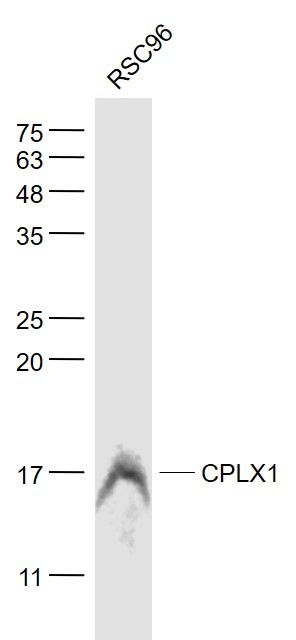 Sample:
Sample:
RSC96(Rat) Cell Lysate at 30 ug
Primary: Anti- CPLX1 (bs-11341R) at 1/1000 dilution
Secondary: IRDye800CW Goat Anti-Rabbit IgG at 1/20000 dilution
Predicted band size: 15 kD
Observed band size: 17 kD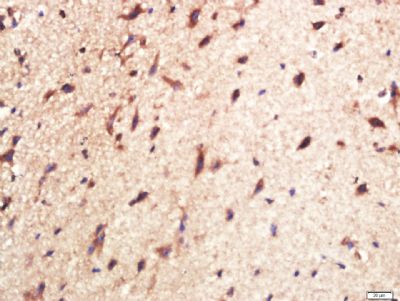 Paraformaldehyde-fixed, paraffin embedded (mouse brain); Antigen retrieval by boiling in sodium citrate buffer (pH6.0) for 15min; Block endogenous peroxidase by 3% hydrogen peroxide for 20 minutes; Blocking buffer (normal goat serum) at 37°C for 30min; Antibody incubation with (CPLX1) Polyclonal Antibody, Unconjugated (bs-11341R) at 1:400 overnight at 4°C, followed by a conjugated secondary (sp-0023) for 20 minutes and DAB staining.
Paraformaldehyde-fixed, paraffin embedded (mouse brain); Antigen retrieval by boiling in sodium citrate buffer (pH6.0) for 15min; Block endogenous peroxidase by 3% hydrogen peroxide for 20 minutes; Blocking buffer (normal goat serum) at 37°C for 30min; Antibody incubation with (CPLX1) Polyclonal Antibody, Unconjugated (bs-11341R) at 1:400 overnight at 4°C, followed by a conjugated secondary (sp-0023) for 20 minutes and DAB staining.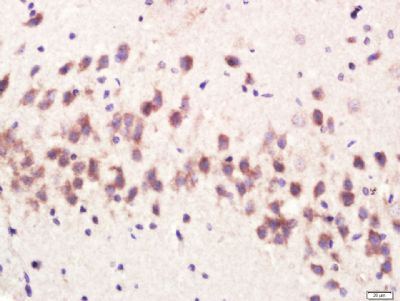 Paraformaldehyde-fixed, paraffin embedded (rat brain); Antigen retrieval by boiling in sodium citrate buffer (pH6.0) for 15min; Block endogenous peroxidase by 3% hydrogen peroxide for 20 minutes; Blocking buffer (normal goat serum) at 37°C for 30min; Antibody incubation with (CPLX1) Polyclonal Antibody, Unconjugated (bs-11341R) at 1:400 overnight at 4°C, followed by a conjugated secondary (sp-0023) for 20 minutes and DAB staining.
Paraformaldehyde-fixed, paraffin embedded (rat brain); Antigen retrieval by boiling in sodium citrate buffer (pH6.0) for 15min; Block endogenous peroxidase by 3% hydrogen peroxide for 20 minutes; Blocking buffer (normal goat serum) at 37°C for 30min; Antibody incubation with (CPLX1) Polyclonal Antibody, Unconjugated (bs-11341R) at 1:400 overnight at 4°C, followed by a conjugated secondary (sp-0023) for 20 minutes and DAB staining.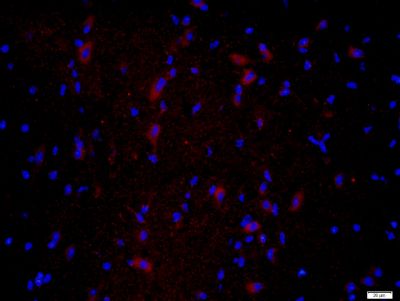 Paraformaldehyde-fixed, paraffin embedded (mouse brain); Antigen retrieval by boiling in sodium citrate buffer (pH6) for 15min; Block endogenous peroxidase by 3% hydrogen peroxide for 20 minutes; Blocking buffer (normal goat serum) at 37°C for 30min; Antibody incubation with (CPLX1) Polyclonal Antibody, Unconjugated (bs-11341R) at 1:400 overnight at 4°C, followed by a conjugated secondary (Goat Anti-rabbit IgG/Bio) for 20minutes at 37°C, followed by a conjugated streptavidin (bs-0437P-Cy3) at[1:500] for 40 minutes and DAPI staining of the nuclei.
Paraformaldehyde-fixed, paraffin embedded (mouse brain); Antigen retrieval by boiling in sodium citrate buffer (pH6) for 15min; Block endogenous peroxidase by 3% hydrogen peroxide for 20 minutes; Blocking buffer (normal goat serum) at 37°C for 30min; Antibody incubation with (CPLX1) Polyclonal Antibody, Unconjugated (bs-11341R) at 1:400 overnight at 4°C, followed by a conjugated secondary (Goat Anti-rabbit IgG/Bio) for 20minutes at 37°C, followed by a conjugated streptavidin (bs-0437P-Cy3) at[1:500] for 40 minutes and DAPI staining of the nuclei.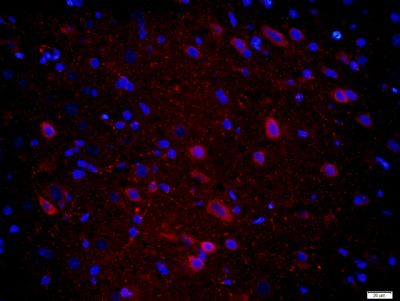 Paraformaldehyde-fixed, paraffin embedded (rat brain); Antigen retrieval by boiling in sodium citrate buffer (pH6) for 15min; Block endogenous peroxidase by 3% hydrogen peroxide for 20 minutes; Blocking buffer (normal goat serum) at 37°C for 30min; Antibody incubation with (CPLX1) Polyclonal Antibody, Unconjugated (bs-11341R) at 1:400 overnight at 4°C, followed by a conjugated secondary (Goat Anti-rabbit IgG/Bio) for 20minutes at 37°C, followed by a conjugated streptavidin (bs-0437P-Cy3) at[1:500] for 40 minutes and DAPI staining of the nuclei.
Paraformaldehyde-fixed, paraffin embedded (rat brain); Antigen retrieval by boiling in sodium citrate buffer (pH6) for 15min; Block endogenous peroxidase by 3% hydrogen peroxide for 20 minutes; Blocking buffer (normal goat serum) at 37°C for 30min; Antibody incubation with (CPLX1) Polyclonal Antibody, Unconjugated (bs-11341R) at 1:400 overnight at 4°C, followed by a conjugated secondary (Goat Anti-rabbit IgG/Bio) for 20minutes at 37°C, followed by a conjugated streptavidin (bs-0437P-Cy3) at[1:500] for 40 minutes and DAPI staining of the nuclei.

